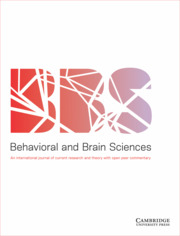Article contents
Compositionality in visual perception
Published online by Cambridge University Press: 28 September 2023
Abstract
Quilty-Dunn et al.'s wide-ranging defense of the Language of Thought Hypothesis (LoTH) argues that vision traffics in abstract, structured representational formats. We agree: Vision, like language, is compositional – just as words compose into phrases, many visual representations contain discrete constituents that combine in systematic ways. Here, we amass evidence extending this proposal, and explore its implications for how vision interfaces with the rest of the mind.
- Type
- Open Peer Commentary
- Information
- Copyright
- Copyright © The Author(s), 2023. Published by Cambridge University Press
References
- 5
- Cited by




Target article
The best game in town: The reemergence of the language-of-thought hypothesis across the cognitive sciences
Related commentaries (30)
A language of episodic thought?
Advanced testing of the LoT hypothesis by social reasoning
Animal thought exceeds language-of-thought
Compositionality in visual perception
Concept learning in a probabilistic language-of-thought. How is it possible and what does it presuppose?
Developmental and multiple languages-of-thought
Do nonlinguistic creatures deploy mental symbols for logical connectives in reasoning?
Evidence for LoTH: Slim pickings
Incomplete language-of-thought in infancy
Is core knowledge in the format of LOT?
Is evidence of language-like properties evidence of a language-of-thought architecture?
Is language-of-thought the best game in the town we live?
Language-of-thought hypothesis: Wrong, but sometimes useful?
Linguistic meanings in mind
Linguistic structure and the languages-of-thought
Natural logic and baby LoTH
Neither neural networks nor the language-of-thought alone make a complete game
Never not the best: LoT and the explanation of person-level psychology
On the hazards of relating representations and inductive biases
Perception is iconic, perceptual working memory is discursive
Properties of LoTs: The footprints or the bear itself?
Putting relating at the core of language-of-thought
Representational structures only make their mark over time: A case from memory
Stop me if you've heard this one before: The Chomskyan hammer and the Skinnerian nail
The computational and the representational language-of-thought hypotheses
The language of tactile thought
The language-of-thought as a working hypothesis for developmental cognitive science
The reemergence of the language-of-thought hypothesis: Consequences for the development of the logic of thought
Toward biologically plausible artificial vision
Using the sender–receiver framework to understand the evolution of languages-of-thought
Author response
The language-of-thought hypothesis as a working hypothesis in cognitive science